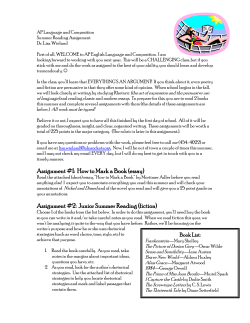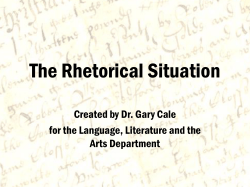
RHETORICAL ANALYSIS
RHETORICAL ANALYSIS KING’S “LETTER FROM A BIRMINGHAM JAIL” RHETORICAL ANALYSIS • Rhetorical analysis is the systematic examination of strategies an author uses to achieve his or her purpose. • These strategies include: • Rhetorical situation • Means of persuasion • Rhetorical strategies RHETORICAL SITUATION • Strategies: • Read headnote • • • • • Author information Historical context Background information Information about the issue Essay’s structure • Clues in essay: • Word and phrase choices reveal preconceptions, context, expectations of reader. • Google • Research author • Research essay’s topic RHETORICAL SITUATION: TRIANGLE • Rhetorical triangle and pentagon: • Writer. Audience. Purpose. • Medium. • Where did it originally appear? • Are there pictures, images, graphs, charts, etc. • Context. RHETORICAL SITUATION: AUDIENCE • To determine audience, look at: • Language • Evidence • Allusions • To analyze audience, ask: • Who is the author’s intended audience? • How does writer see audience? friendly, approachable, hostile, confrontational, intelligent, neutral, open-minded, etc.? • What values do you think the intended audience possesses? • Does the author assume the audience is informed or uninformed? • Is the writer being friendly, confrontational, or neutral toward the reader? • Are there places where the author and reader share anything in common? RHETORICAL SITUATION: PURPOSE • To determine author’s purpose, ask: • Is purpose stated or implied? • Is purpose to convince or to persuade (encourage action)? • Is it to inform, explore, make a decision, or a form of meditation? Or a mixture of some? • Does the author primarily rely on pathos, ethos, or logos? • What does author rely on secondarily? • Does the writer have a hidden agenda? RHETORICAL SITUATION: INFLUENCES • The author • Has author’s background influenced argument’s content? • Look at education, experience, race, gender, political beliefs, religious beliefs, age, experiences, etc. • To analyze author, ask: • What is the author’s background? • How does their background effect the content? • What preconceptions does the author have? RHETORICAL SITUATION: TOPIC • To analyze topic and content, ask: • What is the argument’s topic? • Why did the author write about it? • Is the argument fully developed? RHETORICAL SITUATION: CONTEXT • Context • The situation that creates the need for the argument. • To analyze the context, ask: • What situation, or situations, set the stage for the argument? • What social, political, and cultural events triggered the argument? • What historical references situates this argument in a particular place or time? RHETORICAL SITUATION: MEDIUM • Medium • The medium is the delivery system of the message. • Is the medium an essay, a movie, a book, a review, a letter, a song, etc.? • How does the medium affect the message? • If it’s mixed media, such as text and images, how does that affect the message? MEANS OF PERSUASION • To analyze logos, pathos, and ethos, ask: • Where does the author make these appeals? • Why do you think he chose one appeal type over the other? • How effective is the appeal? • Could another appeal have been more effective? MEANS OF PERSUASION: ETHOS • Ethos – appeals based on character, credibility, and reliability • Where does King make appeals to ethos? MEANS OF PERSUASION: PATHOS • Pathos – appeals based on audience’s needs, emotions, and values. • Where does King make appeals to pathos? MEANS OF PERSUASION: LOGOS • Logos – appeals based on logic or reason. • Often depends on: • Inductive reasoning. • Supplying evidence for conclusions • Deductive reasoning. • Reasoning from premises to reach logical conclusion. • Where does King make appeals to logos? RHETORICAL STRATEGIES • Strategies include: • • • • Thesis statement Organization Evidence Stylistic techniques RHETORICAL STRATEGIES: THESIS • Thesis – the essay’s main argument. • What is King’s thesis? RHETORICAL STRATEGIES: THESIS King’s thesis: • He is “confined here in the Birmingham city jail” • His “present activities” have been determined “unwise and untimely.” • To the point: “But more basically, I am in Birmingham because injustice is here.” RHETORICAL STRATEGIES: ORGANIZATION • Organization – how the writer arranges ideas, thoughts, evidence, etc. • How does King organize his letter? RHETORICAL STRATEGIES: ORGANIZATION King’s organization: • Begins by addressing the charge that his actions are untimely. • He claims his actions are not timely enough – African Americans have “waited for more than 340 years for our constitutional and God given rights” (3). • Then addresses his willingness to break laws. • Makes the distinction between just and unjust laws. • After chiding white moderates for not supporting his cause, he discusses the fact of being accused of extremism. • According to King, this charge is false. If he had not embraced a philosophy of non-violent protest, the streets of the South would be “flowing with blood” (6). • Then points out that contemporary church must “recapture the sacrificial spirit of the early church” (8). • He links his struggle of freedom with the “sacred heritage of our nation and the eternal will of God” (9). • King ends his argument by asserting both his humility and his unity with the white clergy. RHETORICAL STRATEGIES: EVIDENCE • Evidence – the use facts, observations, expert opinions, and other methods and devices to convince the audience. • What evidence does King use? RHETORICAL STRATEGIES: EVIDENCE King’s evidence: • References historical events and persons, such as: • • • • • • Jesus Socrates St. Paul St. Augustine Martin Luther Abraham Lincoln RHETORICAL STRATEGIES: STYLE • Stylistic techniques include: • • • • • • Simile Metaphor Allusion Parallelism Repetition Rhetorical Questions RHETORICAL STRATEGIES: STYLE • Simile – compares two things using like or as • “Like a boil that can never be cured so long as it is covered up but must be opened with all its ugliness to the natural medicines of air and light, injustice must be exposed, with all the tension its exposure creates, to the light of human conscience and the air of national opinion before it can be cured” (5) RHETORICAL STRATEGIES: STYLE • Metaphor – compares two things without using like or as. It also suggests that two things share a quality. • “Frankly, I have yet to engage in a direct action campaign that was ‘well timed’ in the view of those who have not suffered unduly from the disease of segregation” (3). • “When you see the vast majority of your twenty million Negro brothers smothering in an airtight cage of poverty in the midst of an affluent society” (3) RHETORICAL STRATEGIES: STYLE • Allusion – refers to another literary work or passage or references an historical event, cultural event, political event, or other event, or even to a tv show, movie, art work, song, speech, etc. • “I would agree with St. Augustine that ‘an unjust law is no law at all’” (3). • “Of course, there is nothing new about this kind of civil disobedience. It was evidenced sublimely in the refusal of Shadrach, Meshach and Abednego to obey the laws of Nebuchadnezzar” (4). RHETORICAL STRATEGIES: STYLE • Parallelism – the use of a similar structure in the repetition of pairs or series of words, phrases, or clauses. It’s usually used to emphasize an idea or position. • “I wish you had commended the Negro sit inners and demonstrators of Birmingham for their sublime courage, their willingness to suffer, and their amazing discipline in the midst of great provocation” (9). • “Shallow understanding from people of good will is more frustrating than absolute misunderstanding from people of ill will. Lukewarm acceptance is much more bewildering than outright rejection” (5) RHETORICAL STRATEGIES: STYLE • Repetition – involves repeating a word or phrase for emphasis, clarity, or emotional effect. • “‘Are you able to accept blows without retaliating?’ ‘Are you able to endure the ordeal of jail?’” (2). RHETORICAL STRATEGIES: STYLE • Rhetorical Question – a questions that is asked to encourage the reader to reflect on an issue, though they need not answer the question. • “‘How can you advocate breaking some laws and obeying others?’” (3). RHETORICAL STRATEGIES: ASSESSING Assessing the argument strategies: • Begin with assessment. Then support it. • Does an overall argument work? • Show how it does or does not. • Discuss the rhetorical strategies. Then assess their effectiveness. • Point out rhetorical strategies, means of persuasion, and rhetorical situations and analyze their effectiveness. Then make an overall assessment of the argument. REVIEW • This PowerPoint is on Blackboard. • Review it while writing your rhetorical analysis essay. HOMEWORK • Read “Locavore’s Dilemma” (703-06) • Write a draft rhetorical analysis of one of the following essays: • “Is Junk Food Really Cheaper?” (660-64) • “A Diversified Farmer . . .” (691-93) • “The Locavore’s Dilemma” (703-06) • Bring a copy to class • • • • Typed and printed copy Copy on laptop Not a copy on your phone It needs to be in a format that someone can interact with and leave notes.
© Copyright 2025













